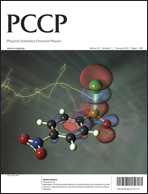铜结合改变了 Y145Stop 人类朊病毒蛋白形成的淀粉样纤维的核心结构
IF 2.9
3区 化学
Q3 CHEMISTRY, PHYSICAL
引用次数: 0
摘要
克雅氏病、疯牛病和瘙痒病等传染性海绵状脑病(或称朊病毒病)的特征是大脑中具有淀粉样纤维特性的折叠错误的朊病毒蛋白聚集体(PrPSc)的积累。鉴于铜和锌等过渡金属离子似乎对细胞 PrP(PrPC)的生理功能以及朊病毒疾病的发病机制都很重要,因此探索它们在蛋白质聚集过程中的作用相当有意义。众所周知,铜(II)尤其能与位于 PrP N 端区域(人类 PrP 氨基酸 60-91)的四个串联八肽重复序列(PHGGGWGQ)结合,还能与八肽区域外的组氨酸结合位点结合,其结合模式随 Cu2+ 浓度的不同而不同。在此,我们以 Y145Stop 人类朊病毒蛋白变体(huPrP23-144)为模型,结合多维溶液和固态核磁共振光谱、原子力显微镜和硫黄素 T 荧光测定法,探究了 Cu2+ 与单体 huPrP23-144 的结合以及这种结合对纤维组装动力学及其结构特性的影响。值得注意的是,我们发现含有一摩尔当量结合 Cu2+ 的 huPrP23-144 形成的纤维采用的核心结构不同于 huPrP23-144 在没有 Cu2+ 的情况下的核心结构,而是对应于含有 A117V 突变的 huPrP23-144 形成的构象应变。与 Cu2+ 结合的 Δ51-91 huPrP23-144 缺失变体也采用了类似 huPrP23-144 A117V 的淀粉样核心结构,该变体缺少整个八瓣区,这表明 Cu2+ 与位于 C 端附近的 His 残基 96、Cu2+与位于 huPrP23-144 C 端附近的 His 残基 96、111 和 140 的结合是导致所观察到的纤维构象改变的主要原因,这可能是由于在纤维组装过程中结合的 Cu2+ 对本质上无序的 huPrP23-144 进行了部分结构化。我们还发现,当在纤化反应中加入预先形成的 huPrP23-144 淀粉样时,由 Cu2+ 结合的 huPrP23-144 形成的纤丝会采用类似原生 huPrP23-144 的结构,而不是类似 A117V 的结构。本文章由计算机程序翻译,如有差异,请以英文原文为准。
Copper binding alters the core structure of amyloid fibrils formed by Y145Stop human prion protein
Transmissible spongiform encephalopathies (or prion diseases) such as Creutzfeldt-Jacob disease, mad cow disease, and scrapie are characterized by accumulation in the brain of misfolded prion protein aggregates (PrPSc) that have properties of amyloid fibrils. Given that transition metal ions, such as copper and zinc, appear to be important for physiological functions of cellular PrP (PrPC) as well as for prion disease pathogenesis, exploring their role in the protein aggregation process is of considerable interest. Copper(II) in particular is well-known to bind to the four tandem octapeptide repeats (PHGGGWGQ) located in the N-terminal region of PrP (human PrP amino acids 60-91), as well as to additional histidine binding sites outside the octarepeat region with distinct binding modes depending on Cu2+ concentration. Here, using the Y145Stop human prion protein variant (huPrP23-144) as a model and a combination of multidimensional solution and solid-state NMR spectroscopy, atomic force microscopy and thioflavin T fluorescence assays we probed the binding of Cu2+ to monomeric huPrP23-144 and the impact of this binding on fibril assembly kinetics and their structural properties. Remarkably, we found that fibrils formed by huPrP23-144 containing one molar equivalent of bound Cu2+ adopt a core structure that is distinct from that found for huPrP23-144 in the absence of Cu2+ but, instead, corresponds to a conformational strain formed by huPrP23-144 containing the A117V mutation. A similar huPrP23-144 A117V-like amyloid core structure was adopted by a Cu2+-bound Δ51-91 huPrP23-144 deletion variant lacking the entire octarepeat region, suggesting that Cu2+ binding to His residues 96, 111 and 140 located near the C-terminus of huPrP23-144 is primarily responsible for the observed change in fibril conformation, potentially due to partial structuring of the intrinsically disordered huPrP23-144 by the bound Cu2+ during the fibril assembly process. We also found that fibrils formed by Cu2+-bound huPrP23-144 adopt the native huPrP23-144-like rather than A117V-like structure when the fibrillation reaction is seeded with pre-formed huPrP23-144 amyloid.
求助全文
通过发布文献求助,成功后即可免费获取论文全文。
去求助
来源期刊

Physical Chemistry Chemical Physics
化学-物理:原子、分子和化学物理
CiteScore
5.50
自引率
9.10%
发文量
2675
审稿时长
2.0 months
期刊介绍:
Physical Chemistry Chemical Physics (PCCP) is an international journal co-owned by 19 physical chemistry and physics societies from around the world. This journal publishes original, cutting-edge research in physical chemistry, chemical physics and biophysical chemistry. To be suitable for publication in PCCP, articles must include significant innovation and/or insight into physical chemistry; this is the most important criterion that reviewers and Editors will judge against when evaluating submissions.
The journal has a broad scope and welcomes contributions spanning experiment, theory, computation and data science. Topical coverage includes spectroscopy, dynamics, kinetics, statistical mechanics, thermodynamics, electrochemistry, catalysis, surface science, quantum mechanics, quantum computing and machine learning. Interdisciplinary research areas such as polymers and soft matter, materials, nanoscience, energy, surfaces/interfaces, and biophysical chemistry are welcomed if they demonstrate significant innovation and/or insight into physical chemistry. Joined experimental/theoretical studies are particularly appreciated when complementary and based on up-to-date approaches.
 求助内容:
求助内容: 应助结果提醒方式:
应助结果提醒方式:


